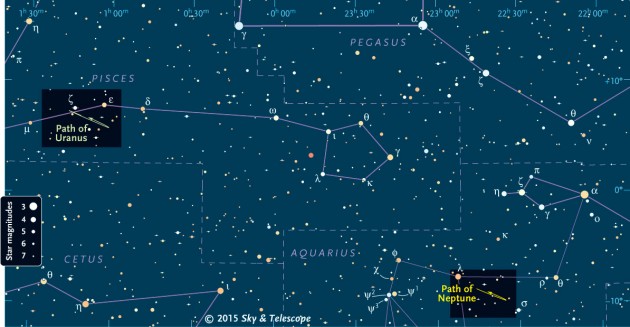This article gives directions for finding Uranus and Neptune from June 2015 through March 2016. If you've never seen these somewhat dim planets before, you might want to read our general instructions and history of their discoveries first.

Sky & Telescope diagram
Neptune and Uranus are in Aquarius and Pisces, respectively, throughout this period. Uranus is fewer than 10° north of the celestial equator, and Neptune will be 10° to the south of the center line at the end of 2015 — so neither gets very high in the sky for people at mid-northern latitudes. So it's important to make the best of the relatively short window of opportunity for viewing them. Neptune rises first, but because it's so much fainter, it won't actually be visible much earlier. Sometime in June or July, both planets become high enough for decent telescopic viewing in the predawn sky.
Click here to download a detailed, printable chart for Uranus and Neptune in PDF format.
Neptune reaches opposition to the Sun on September 1st (3:24 UT), and Uranus on October 12th (3:36 UT). These are the dates when the planets rise around sunset, set around sunrise, and reach their highest in the sky in the middle of the night. Neptune is reasonably well placed in the evening sky from August through December, and Uranus from September through February 2016. They're detectable after that, but too low for high-power telescopic observing.
Interested in Pluto? Read more about its discovery in David Levy's biography of Clyde Tombaugh.
 0
0
Comments
You must be logged in to post a comment.